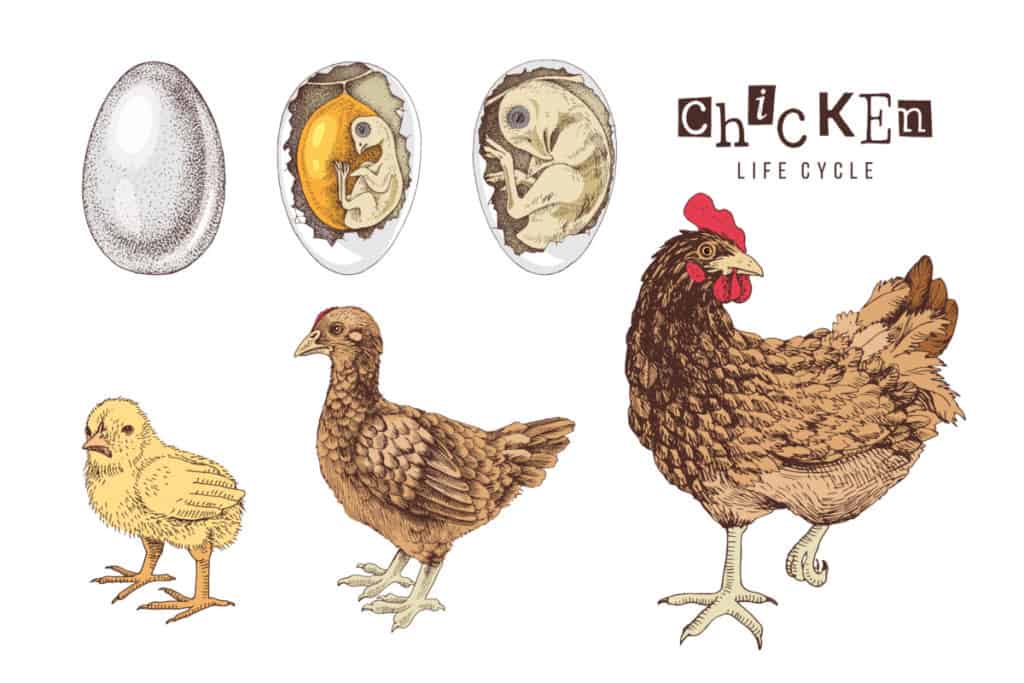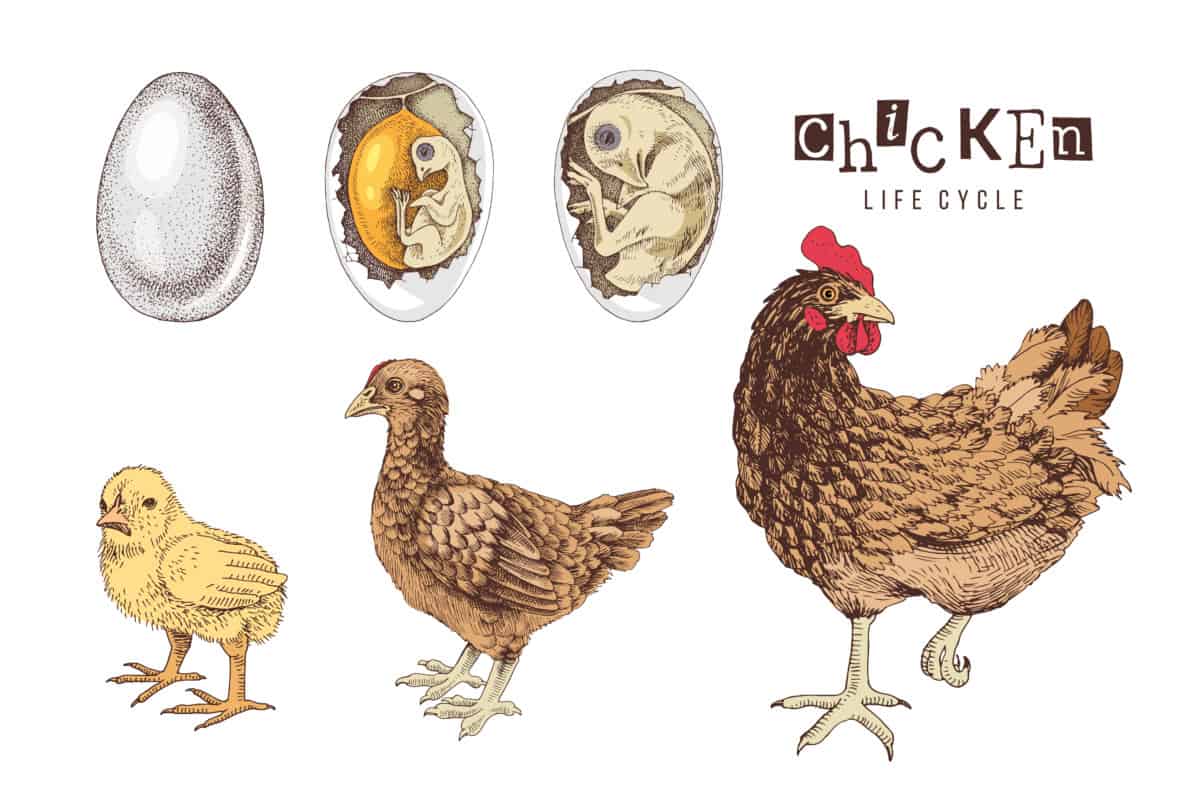Chickens are such a common sight in a farmyard that they are almost taken for granted. Not many people think twice about them or their lives. Most people eat eggs regularly without thinking about how they are produced. Chickens are interesting creatures that are fascinating to observe.
Chickens have five stages in their life cycle. They are an embryo in an egg, the hatchling, chick, pullet, or cockerel, and the adult hen or rooster. The chicken breed and care determine the length of the chicken’s life. The growth and development are also affected by breeding and feeding.
There are some interesting and surprising facts to learn about the life cycle of chickens. Did you know that chicks can chirp before they hatch or that an eggshell is semi-permeable?

How Many Stages Are There In A Chicken Life Cycle?
Most people think there are only three stages to a chicken’s life cycle. Chicken, egg, and chick. There are, surprisingly, five stages to a chicken life cycle. They are:
- An embryo in an egg
- A hatchling
- A chick
- A pullet or cockerel
- A hen or rooster.
All About Chicken Eggs.
Eggs are laid by hens, usually every 24 hours, although some chickens may only lay every second day. The hen lays a clutch of eggs before she starts to sit or incubate the eggs.
Eggs consist of five basic parts. The shell is the firm outer casing that is made up of calcium carbonate crystals. The eggshell is semi-permeable – air and moisture can move in and out of it. A very thin outer layer called the cuticle ( or bloom) protects the egg from dust and bacteria.
Under the eggshell, you will find two membranes – the outer and inner membranes made up of keratin. These two membranes protect the egg against pathogen entry. The air cell is a critical region in the egg. It is located at the broad end of the egg, just under the shell.
The egg white is known as albumen, and it is in this liquid protein that the embryo will develop. The albumen closest to the yolk is thick but becomes thinner closer to the shell.
The egg yolk is yellow to orange and is surrounded by a membrane called the vitelline membrane. The egg yolk is held in place in the egg by two twisted strands called the chalazae.
How Does A Chick Grow In An Egg?
The hen ovulates and produces an oocyte which will ultimately become the egg yolk. The rooster mates with the hen, and during this process, the sperm fertilizes the oocyte.
There will be a tiny white spot on the egg yolk where the sperm has entered the oocyte. This spot is known as the germinal disc or blastodisc. The fertilized oocyte begins to reproduce cells as it continues down the oviduct channel.
Once the egg is laid and cools, the reproduction of cells halts temporarily until the hen begins to incubate the eggs. Once the hen starts sitting and the eggs warm-up, the cells resume their activity, and the embryo grows. The chick inside the shell is referred to as an embryo.
The embryo develops inside the albumen, using the protein-rich environment to assist with growth. It is attached to the yolk through an umbilical cord, and the embryo obtains nutrients from the yolk allowing it to grow.
How Long Is A Chicken’s Incubation Period?
The hen will sit on eggs for 21 days, at which time the chicks will hatch. On the twentieth day of incubation, the embryo’s neck muscle begins to contract, and the beak breaks through into the egg’s air cell. The embryo starts to chirp. These cheeping eggs may be heard clearly if you are near the nest.
The chirping stimulates the other embryos to begin hatching. A small tooth on top of the embryo’s beak helps it break through the shell on day twenty-one. If you are interested in seeing more about the development of the chicken embryo, watch below.
The Chicken Hatchling.
Hatching is very tiring, and the hatchling will need to rest between attempts to break free entirely from the egg. Initially, the hatchling is wet, and it will spend some time sleeping after hatching. As the hatchling dries, its down becomes fluffy, and the tooth on the beak falls off.
Just before hatching, the chick absorbs the remaining yolk. This allows the chick to go for two or three days before it needs to eat or drink. The delay in the need for food and water is essential as it allows the hen to sit on the nest until all the eggs have hatched.
How Quickly Does A Chick Grow?
Chicks begin eating small grains or tiny pieces of food. They are stimulated to eat by their mother clucking and pecking the food. Chicks all grow quickly, but the chicken breed determines the rate of growth.
When Do Chicks Get Feathers?
Chicks will begin to get feathers on their wings within the first week of life. By five weeks, the chicks will have feathers on most of their body. Chicks hatched under a hen will still try to sit under her wings at night, but space will be limited due to the size of the chicks.
When Can You Tell The Sex Of A Chick?
The chicks begin growing their wattles and combs at five to six weeks. The males usually have larger, redder combs and wattles than females. Male chicks also tend to have thicker, chunkier legs than females. It is possible to determine the sex between six to eight weeks.
Professional chicken keepers can determine sex on the first day of hatching. The chicken’s vent is examined, but this is an invasive process, and many chicks die.

How Do Hens And Roosters Develop?
The average age for hens to begin laying eggs is six months. Some hens can start as early as four months, and others will begin laying at eight months. Roosters become sexually mature at approximately four to five months.
The age of sexual maturity in roosters also depends on the breed. Roosters begin to challenge each other for dominance, with the resulting fights causing severe injuries and even death. Some roosters are highly aggressive and will even attack their owners.
How Long Do Chickens Live?
Usually, chickens live between five to eight years. Some breeds are longer lived than others and may live up to ten to twelve years, but this is unusual. Other chickens have relatively short lives and will only live until they are three or four years old.
What Came First The Chicken Or The Egg?
This is a question many people like to toss around as a philosophical or humorous topic. The answer must be the chicken. Without a hen to lay the egg, there would be no chick. If a hen did not incubate the egg that the rooster fertilized, there would be no chick to hatch. So next time you asked this question, you can answer with confidence – the chicken came first!
Conclusion
A chicken’s life cycle is interesting. It begins with a hen laying an egg, which in turn produces a new chicken. There are many fascinating facts to learn about chickens. Some chickens can live for a relatively long time, but many are culled early for meat or when their egg production reduces.

